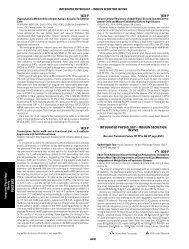Pro-inflammatory CD11c CD206 adipose tissue ... - Diabetes
Pro-inflammatory CD11c CD206 adipose tissue ... - Diabetes
Pro-inflammatory CD11c CD206 adipose tissue ... - Diabetes
Create successful ePaper yourself
Turn your PDF publications into a flip-book with our unique Google optimized e-Paper software.
2<br />
Adipose <strong>tissue</strong> macrophages in human obesity<br />
Objective: Insulin resistance and other features of the metabolic syndrome have been causally<br />
linked to <strong>adipose</strong> <strong>tissue</strong> macrophages (ATMs) in mice with diet-induced obesity. We aimed to<br />
characterize macrophage phenotype and function in human subcutaneous and omental <strong>adipose</strong><br />
<strong>tissue</strong> in relation to insulin resistance in obesity.<br />
Research Design and Methods: Adipose <strong>tissue</strong> was obtained from lean and obese women<br />
undergoing bariatric surgery. Metabolic markers were measured in fasting serum and ATMs<br />
characterized by immunohistology, flow cytometry and <strong>tissue</strong> culture studies.<br />
Results: ATMs comprised <strong>CD11c</strong> + <strong>CD206</strong> + cells in ‘crown’ aggregates and solitary <strong>CD11c</strong> -<br />
<strong>CD206</strong> + cells at adipocyte junctions. In obese women, <strong>CD11c</strong> + ATM density was greater in<br />
subcutaneous than omental <strong>adipose</strong> <strong>tissue</strong> and correlated with markers of insulin resistance.<br />
<strong>CD11c</strong> + ATMs were distinguished by high expression of integrins and antigen presentation<br />
molecules, interleukin (IL)-1β, -6, -8 and -10, tumor necrosis factor-α and CC chemokine<br />
ligand-3, indicative of an activated, pro-<strong>inflammatory</strong> state. In addition, <strong>CD11c</strong> + ATMs were<br />
enriched for mitochondria and for RNA transcripts encoding mitochondrial, proteasomal and<br />
lysosomal proteins, fatty acid metabolism enzymes and T-cell chemoattractants, whereas <strong>CD11c</strong> -<br />
ATMs were enriched for transcripts involved in <strong>tissue</strong> maintenance and repair. Tissue culture<br />
medium conditioned by <strong>CD11c</strong> + ATMs, but not <strong>CD11c</strong> - ATMs or other stromovascular cells,<br />
impaired insulin-stimulated glucose uptake by human adipocytes.<br />
Conclusions: These findings identify pro-<strong>inflammatory</strong> <strong>CD11c</strong> + ATMs as markers of insulin<br />
resistance in human obesity. In addition, the machinery of <strong>CD11c</strong> + ATMs indicates they<br />
metabolize lipid and may initiate adaptive immune responses.
















